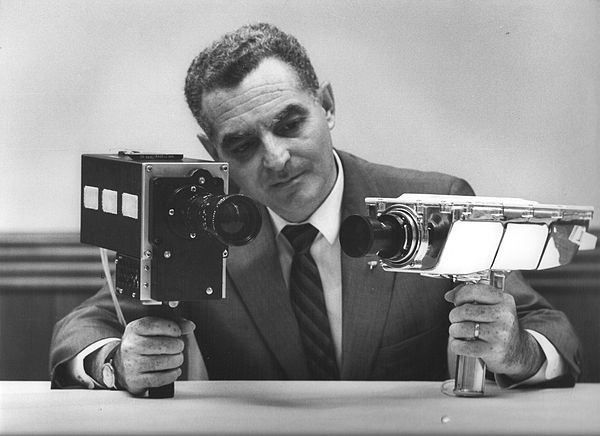The Television Portal

Television (TV) is a telecommunication medium for transmitting moving images and sound. The term can refer to a television set, or the medium of television transmission. Television is a mass medium for advertising, entertainment, news, and sports.
Television became available in crude experimental forms in the 1920s, but only after several years of further development was the new technology marketed to consumers. After World War II, an improved form of black-and-white television broadcasting became popular in the United Kingdom and the United States, and television sets became commonplace in homes, businesses, and institutions. During the 1950s, television was the primary medium for influencing public opinion. In the mid-1960s, color broadcasting was introduced in the U.S. and most other developed countries.
In 2013, 79% of the world's households owned a television set. The replacement of earlier cathode-ray tube (CRT) screen displays with compact, energy-efficient, flat-panel alternative technologies such as LCDs (both fluorescent-backlit and LED), OLED displays, and plasma displays was a hardware revolution that began with computer monitors in the late 1990s. Most television sets sold in the 2000s were flat-panel, mainly LEDs. Major manufacturers announced the discontinuation of CRT, Digital Light Processing (DLP), plasma, and even fluorescent-backlit LCDs by the mid-2010s. LEDs are being gradually replaced by OLEDs. Also, major manufacturers have started increasingly producing smart TVs in the mid-2010s. Smart TVs with integrated Internet and Web 2.0 functions became the dominant form of television by the late 2010s. (Full article...)
Selected article -
Selected image -

The Apollo TV camera refers to several television cameras used in the Apollo program's space missions, and on the later Skylab and Apollo-Soyuz Test Project missions, in the late 1960s and 1970s. These cameras varied in design, with image quality improving significantly with each successive model. Two companies made these various camera systems: RCA and Westinghouse. Originally, these slow-scan television (SSTV) cameras, running at 10 frames-per-second (fps), produced only black-and-white pictures and first flew on the Apollo 7 mission in October 1968. A color camera — using a field-sequential color system — flew on the Apollo 10 mission in May 1969, and every mission after that. The Color Camera ran at the North American standard 30 fps. The cameras all used image pickup tubes that were initially fragile, as one was irreparably damaged during the live broadcast of the Apollo 12 mission's first moonwalk. Starting with the Apollo 15 mission, a more robust, damage-resistant camera was used on the lunar surface. All of these cameras required signal processing back on Earth to make the frame rate and color encoding compatible with analog broadcast television standards.
Did you know (auto-generated) -

- ... that the replacement of arts listings television show 01-for London was described as "like having to swap a bright yellow curvy Japanese sports car for a dumpy little khaki-coloured old Ford Fiesta"?
- ... that Montana television station KOPR-TV brought forward its start date by several months, only to last just one year?
- ... that Filipina actress Angel Aquino has been described as a "perennial villainess" for portraying several antagonistic roles on television?
- ... that 2 Cheap Cars withdrew a television advertisement in New Zealand because children were copying the main character's catchphrase, "Ah so", which they sometimes pronounced "asshole"?
- ... that South Carolina's first television station, WCOS-TV, "could not stand the economic gaff" and folded less than three years after starting up?
- ... that Angeline Quinto became the first Filipino singer to release a soundtrack album for a television series that featured a single artist?
Selected quote -
More did you know
- ...that the book South Park and Philosophy: You Know, I Learned Something Today analyzes the animated television comedy series South Park using philosophical concepts?
- ...that the 1994 Guinness television advertisement Anticipation used jump cutting techniques to make an actor appear to be performing a physically impossible dance?
- ...that the proposed BBC television special Planet Relief, created to raise awareness of climate change, was cancelled before it was made, for fear that it would be biased against climate sceptics?
- ..that the time traveling premise featured in the Chrono series of video games was inspired by such television programs as The Time Tunnel?
- ...that Russian television implied that Filipp Kirkorov won the Eurovision Song Contest 1995 with "Kolibelnaya Dlya Vulkana" when he in fact only came 17th?
Selected biography -
Pierino Ronald "Perry" Como (/ˈkoʊmoʊ/; May 18, 1912 – May 12, 2001) was an American singer, actor, and television personality. During a career spanning more than half a century, he recorded exclusively for RCA Victor for 44 years, from 1943 until 1987.
"Mr. C.", as he was nicknamed, reportedly sold over 100 million records worldwide and pioneered a weekly musical variety television show. His weekly television shows and seasonal specials were broadcast throughout the world. He recorded primarily vocal pop and was renowned for recordings in the intimate, easy-listening genre pioneered by multimedia star Bing Crosby. In the official RCA Records Billboard magazine memorial, his life was summed up in these few words: "50 years of music and a life well lived. An example to all." (Full article...)
































































